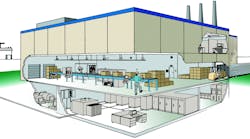The folks at Werner Electric Supply, Appleton, WI, are eagerly awaiting the arrival of an unusual new tool for teaching their customers about process control. Their customers are getting excited about it too, asking when they can see it and get their technicians scheduled to spend time with the new device. Werner’s sales force has been talking it up for months now.
“They keep asking, when are you going to be done with it? We want to see it,” says Rodney Howard, Werner’s product manager for process control.
No one is more eager to see it than Howard. The Werner Electric Process Trainer is his brainchild, and he expects to get to see it for the first time sometime in early May.
The Process Trainer is Werner Electric Supply’s response to the ever-present challenge of helping customers master the intricacies of process control instrumentation, systems design, programming, operation, maintenance and data gathering without the risks of a mistake shutting down a live production plant.
Howard is a professional engineer and ISA-certified automation professional, and his background includes work on power plants for Wisconsin Public Service. In that role he oversaw control system projects and developed software-based high-fidelity simulators to replicate the entire control system of a 500MW power plant. It was that experience that kindled his interest in hands-on training. But instead of a software-based simulator, he wanted to offer Werner customers a more direct learning experience.
The Werner Electric Process Trainer consists of see-through acrylic tanks, one 40 gallons and one 25 gallons, and a smaller double-walled stainless steel cooling tank with a viewing port, all connected with every kind of device, instrument and sensor typically found in a process control system — about 20 different pieces of instrumentation in all. It’s mounted on a wheeled cart and configured so that its overall measurements — approximately 26 inches wide, 80 inches tall and 81 inches long —allow it to be wheeled through a doorway and loaded in the back of a truck.
“This is a hands-on process trainer where we can simulate any of the process control disciplines or control elements – whether it be temperature, pressure, flow, conductivity, pH – it’s all on this trainer,” Howard says. “In basic, we’re moving water around, but we’re also using all the elements of control that you would find in industry.”
For example, it can simulate clean-in-place (CIP) systems used in food processing. “We’ve got block and bleed valves that simulate what would happen in a dairy,” he says. “Once you run the dairy product through you have to go back and clean the line using a CIP system, which would consist of doing an acid wash, and then a caustic wash, and then a final rinse, and that’s all done through spray balls or directly in the line. We can simulate that. Even though we’re just pumping out of our water tank, on the graphic it looks like we’re in CIP mode and the students can see that, yes, the spray ball is going, the spray valve closes and a bleed valve returns the simulated CIP back to the tank.”
Howard developed his design in Microsoft Visio, sketching out the processes, the controls and instrumentation, and the types of training Werner could do with it, then created at 3D rendering to share with fabricators who are now building the trainer. The acrylic tanks are being built by a custom aquarium manufacturer in Minnesota and the pressure tank by a stainless specialist. He is adamant about having the fabricators directly involved in solving the technical problems, which they’ve done by, for example, using the hand rail as a pressure tank for storing instrument air.
Bringing the Process Trainer to fruition involved crucial support from Werner Electric’s vendors and the International Society of Automation (ISA), which gave Howard valuable feedback on the design and has partnered with Werner to do training at Werner’s facilities. “Our vendor partners have been very generous,” Howard says. “When they understood what we’re doing and the fact that we’re also partnered with the ISA, and understood the depth to which we went make this happen, they were very generous and donated most of the instrumentation on it or gave us some excellent pricing so they could be a part of this.”
The finished trainer will include a stainless-steel plate etched with the names of all those involved in its design and construction.
Once it’s wheeled into Werner Electric’s Appleton offices for the first time a couple of months from now, the Process Trainer will be in high demand. The training Werner will be able to offer customers with its new device will range from the very basics to the highest level of system control and feeding the generated data into the enterprise.
“At the instrumentation level, we would like to be able to take deep dives where we can take a single transmitter that maybe speaks a protocol like Foundation Fieldbus that not a lot of people have experience with, and we can train people on the fundamentals of how you set this transmitter up. That could be one element of the training,” Howard says. “Then we can expand that, and say, ‘You know Foundation Fieldbus on this pressure transmitter, it tells you a lot of diagnostic data, so now that we know how to set it up and read pressure, as an example, why don’t we also now take that diagnostic data and tie it into the control system so we can then tie it into third-party software that kicks out a work order that tells you when it has failed. Let’s talk about that.’
“Then you can go higher and you say, ‘Now we’re going to bring all this data in and this is how you take the analytics of this process and use that in your company in the form of reports, look-aheads on purchasing pump seals or as part of your intelligent asset management system,” he says.
Howard envisions the training offerings as a scalable system ranging from beginning device training to serving as a platform for plant engineers to work out their thinking on plant changes and new production lines.
“The training program can be as scalable as we need, from self-directed courses all the way up into a room full of engineers that are seriously considering doing some intelligent asset management and feeding that information into their company enterprise systems,” Howard says. “We can show them, ‘This is how we did it. These would be considered best practices.’ They can see first-hand how easy it is, or how complicated it is, and when they walk out of here they know what they’re getting into. It’s not just a simulation that we’re walking people through, it’s hands-on. That’s the goal.”
Werner Electric plans to take the Process Trainer around to customer sites for one-day classes where they can talk about anything the customer wants to know. For example flow-control tuning, level control tuning and more. “We’ll have a whole different set of training on the principles of, how do you set a PID (proportional–integral–derivative) controller up? In your logic, how do you do it? Now once you manually start the flow, how do you put it into automatic control and how do you tune it so that when you make a set-point change it goes up to that set-point and stays there? How do you do that? We can show them that.”
Along the way, another goal is to generate interest among young people who are unaware of opportunities in automation.
“There are fewer people, professionals, getting into process control,” Howard says. “We’re hearing customer tales all the time that it’s hard for them to hire people, and we have issues at Werner hiring technical people, that’s just the state of affairs around the country.”
“We want to spark some enthusiasm, some head-scratching, some ‘What are you doing there? This looks pretty cool,’” he adds. Werner plans to take the Process Trainer around to schools where they can expose students to concepts such as human-machine interface (HMI) graphics that might pique their interest. “A lot of the kids are very interested in game development. They play games. Well, when you show them, ‘Here’s an HMI, a human machine interface graphic, you need to create that graphic, you need to tie it in to the logic of the system, it needs to work, you need to trouble-shoot it … all of a sudden you see that there’s an interest growing.”
Werner Electric Supply made the decision to invest some serious resources in building and deploying the Werner Electric Process Trainer. Howard says the budget for the project was $100,000, and development has included integrating the trainer into Werner’s overall company business plan, developing vision statements as well as all the coursework formats and materials. The company has considered building more than one and offering them to other distributors or third parties, but hasn’t determined yet whether to go that way. There’s also the idea of building another trainer along the same lines for motion control.
For now, though, while they wait for it to arrive, it’s all about heightened anticipation.
“We want it to work and we want to generate enthusiasm around it,” Howard says. “We want to get folks exposed to what process control and instrumentation is all about.”
[Editors note: This version has been corrected from the printed version, correcting the sizes of the acrylic tanks.]










